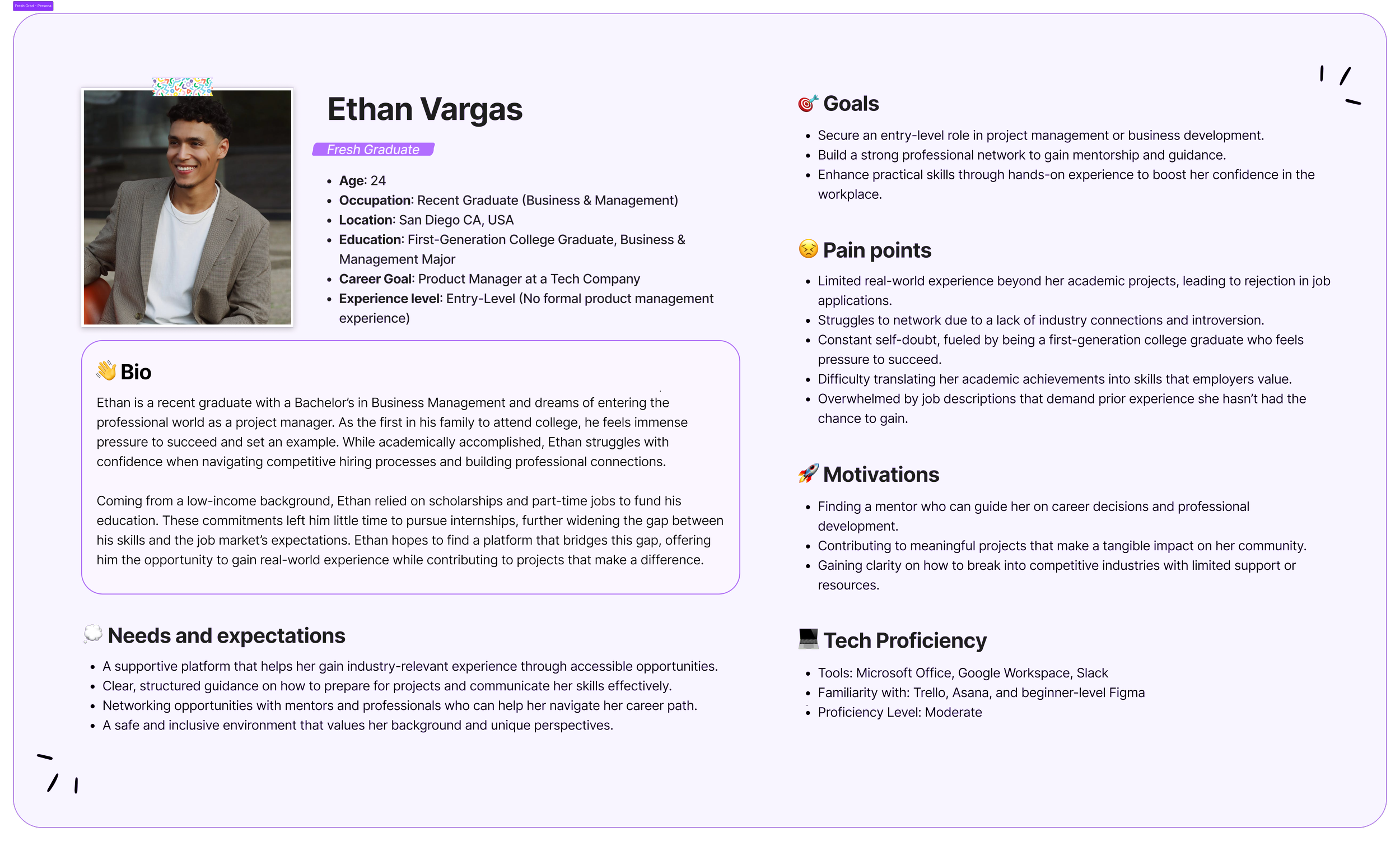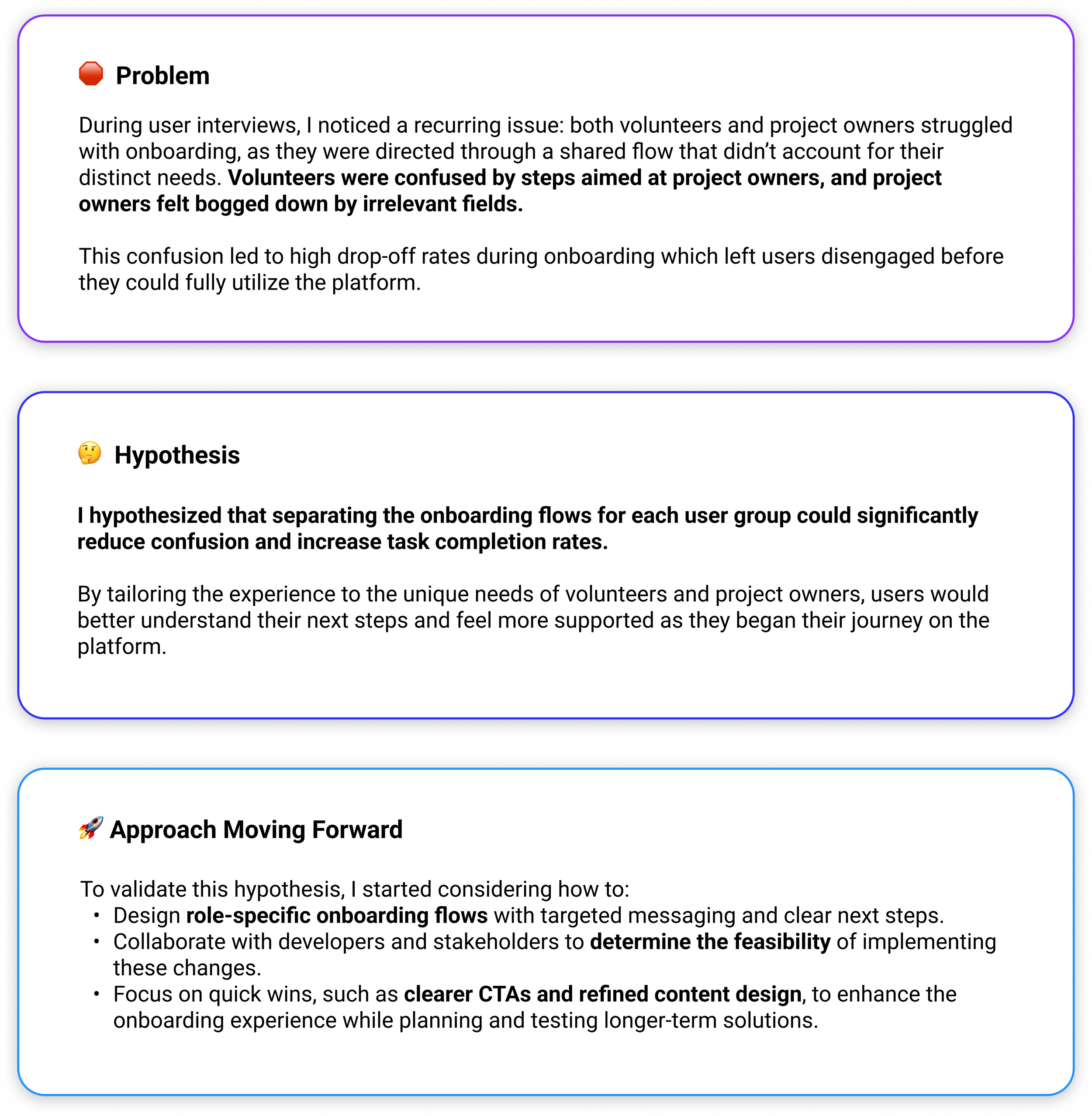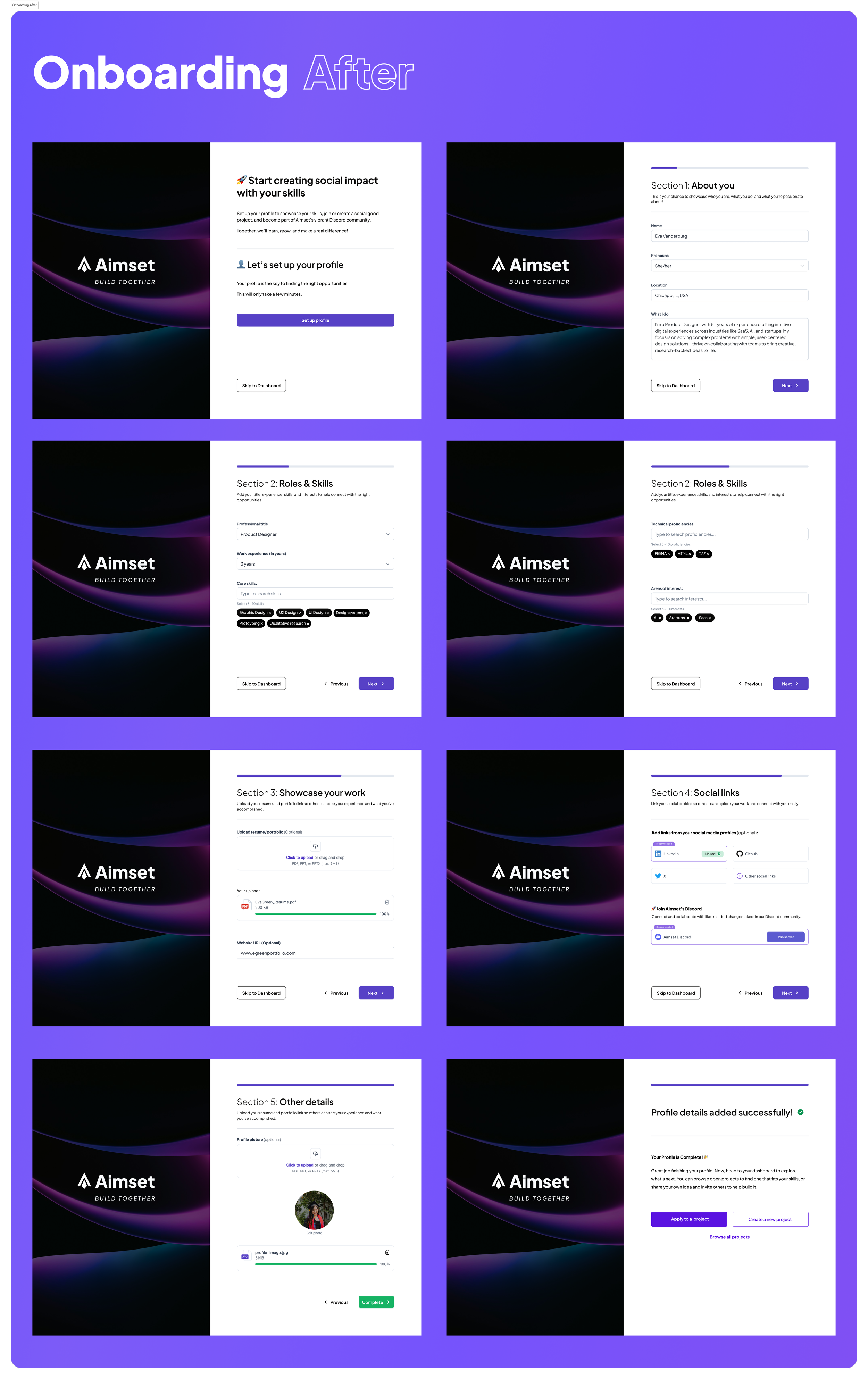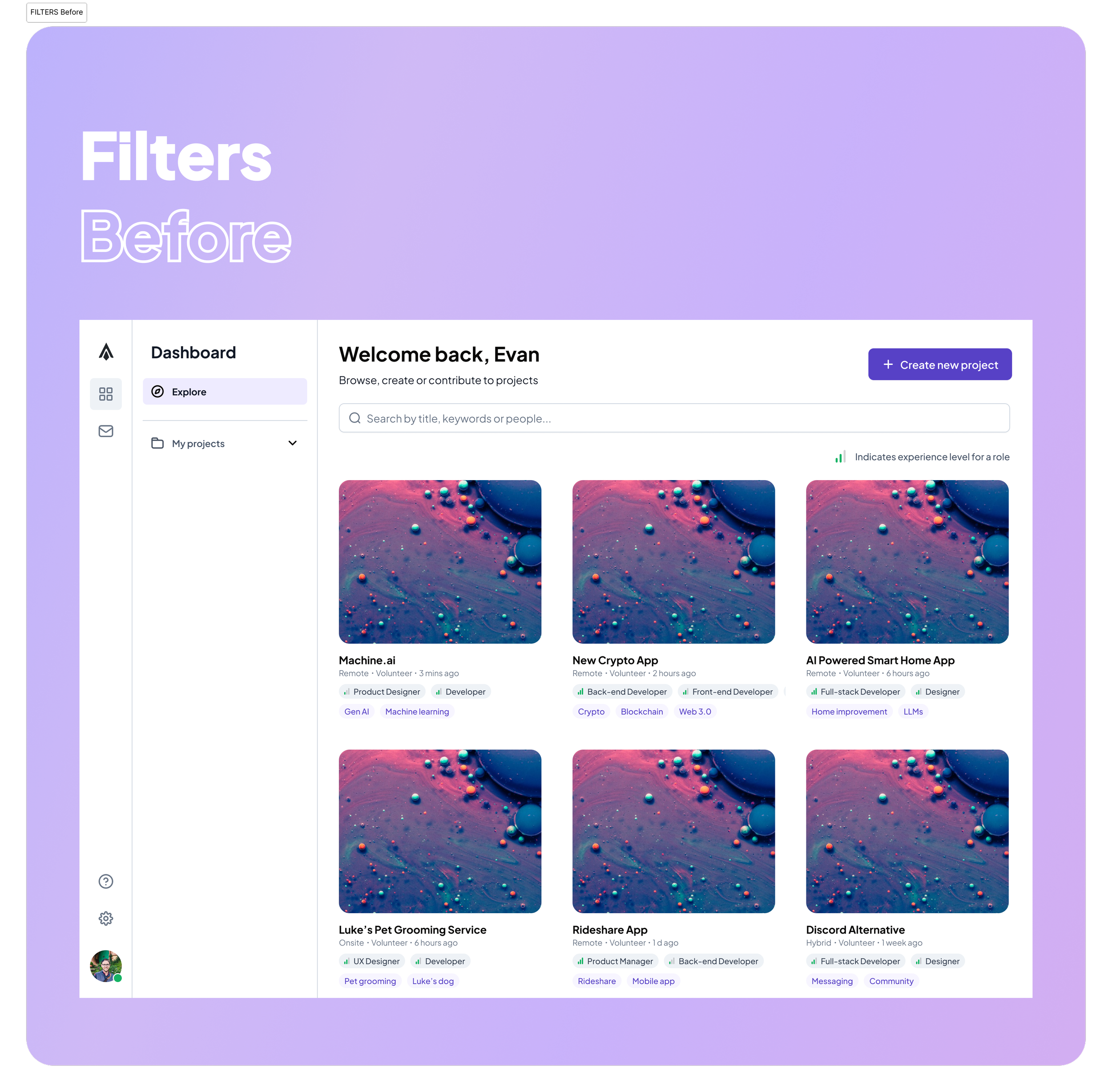
My work as Design Lead focused on leading Aimset toward a reimagined platform that not only serves all fresh graduates but also actively addresses barriers faced by underrepresented groups.
I guided the team in defining and delivering user-centered solutions while taking on key design tasks myself. This balance of leadership and hands-on contributions allowed me to shape the platform strategically while ensuring its practical, user-friendly implementation.
By enhancing equity, usability, and accessibility, the platform empowers users to grow their careers while supporting social innovation.
My team’s results:
57% reduction in onboarding drop-off rates, helping more users access opportunities.
25% increase in task completion rates for volunteers and project owners, driving meaningful connections.
40% improvement in project discovery rates, enabling users to find relevant projects faster.
Empowered entrepreneurs with limited capital to connect with skilled volunteers, allowing them to build impactful projects.
Enhanced platform accessibility and clarity through tailored UX writing and inclusive design.
Aimset was created to bridge the gap between education and practical experience for fresh graduates, career switchers, and entrepreneurs. While designed for all users, the platform’s mission aligned closely with addressing systemic barriers often faced by underrepresented groups, such as first-generation college graduates and entrepreneurs with limited capital.
My role as Design Lead was to create solutions that worked for everyone while ensuring the platform’s usability and accessibility delivered on its inclusive mission.
About Aimset
Reduce onboarding drop-off rates by improving clarity and usability.
Enhance project discovery with robust filters and tailored workflows.
Empower entrepreneurs with limited capital by providing guidance and templates.
Ensure WCAG-compliant accessibility for an inclusive platform experience.
Key Objectives
Project Phases
Discover | Strategize | Design | Implement | Reflect
🎯 Problem Statement
Fresh graduates and career switchers often lack the practical experience required to secure their first roles, while entrepreneurs with limited capital struggle to access skilled collaborators.
These gaps create barriers to entry that disproportionately affect individuals from underrepresented or non-traditional backgrounds, leaving many socially impactful ideas unrealized.
How might we design a platform that empowers fresh graduates, career switchers, and resource-constrained entrepreneurs by simplifying navigation, improving transparency, and fostering equitable collaboration opportunities?
Understanding User Needs
We began the discovery phase by addressing the diverse needs of Aimset’s users. While the original personas provided a solid foundation, I encouraged the team to revisit how the platform served underrepresented populations. This discussion renewed our commitment to ensuring that the platform’s features addressed systemic barriers faced by these groups, aligning with Aimset’s mission of fostering inclusivity and equity. From this process, three main personas emerged:
Fresh Graduate: Representing individuals seeking to gain hands-on experience to kickstart their careers.
Aspiring Entrepreneur: Reflecting small business owners and entrepreneurs with limited resources looking for skilled volunteers to realize their ideas.
Career Switcher (Secondary): Capturing professionals transitioning into new industries who need opportunities to build relevant experience.
While the platform accommodates a wide range of users, our primary focus was on the fresh graduate and aspiring entrepreneur, as these groups faced the most significant barriers to access and opportunity. The career switcher persona, while secondary, offered critical insights into leveraging Aimset to support non-traditional career pathways.
By addressing the unique needs of these personas, Aimset aimed to bridge gaps in experience while driving equity and meaningful social impact.
Through targeted user research, I validated the relevance of these personas and leveraged them to guide the user interview process. This research informed key design decisions, addressing users’ most pressing challenges and ensuring the platform aligned with their needs.
Fresh Grad Persona
Aspiring Entrepreneur Persona
Mapping the Research Sprint
From Personas to Insights
With a clear understanding of our three primary personas—fresh graduates, aspiring entrepreneurs, and career switchers—we identified the critical barriers and opportunities they face. This foundation guided our research phase, where we sought to uncover actionable insights that would address their unique challenges and inform our design strategy. By framing targeted research questions, we ensured that the needs of these diverse users remained at the heart of our process.
To address the gaps in user data following the refined personas, I structured a research sprint to uncover actionable insights.
This timeline highlights the key phases—prototyping, interviews, usability testing, and analysis—that I organized to align the team’s efforts and ensure we effectively tackled the most pressing user issues.
Guiding Questions to Shape the Research
Research Methods
User Interviews: Conducted interviews with 10 participants (5 volunteers, 5 project owners) to understand goals, frustrations, and workflows.
Usability Testing: Observed task completion rates and navigation challenges in onboarding, filtering, and the application process with 8 participants.
Surveys: Distributed quantitative data from surveys of 76 users;
With a clear plan in place, my team and I conducted user interviews, usability testing, and surveys to validate the personas and uncover key pain points. These findings became the cornerstone of the design process.
We framed key research questions that aligned with Aimset’s mission to empower underserved communities and enhance collaboration:
What barriers prevent volunteers from navigating the platform and applying for projects?
How do volunteers and entrepreneurs find opportunities or skilled collaborators, and what frustrations do they face with similar platforms?
What challenges do project owners, especially underserved entrepreneurs, encounter when creating and managing project postings?
How can Aimset better support collaboration between volunteers and project owners?
What accessibility gaps or usability issues hinder engagement for all users?
Through user interviews, surveys, and usability testing, I worked with my team to identify the core needs, frustrations, and wants of Aimset's users. These findings became the foundation for prioritizing design improvements and aligning the platform with user expectations.
User Needs, Frustrations, and Wants
⚡️Emergent Challenge
Key User Insights
The user research and emergent challenge provided clear direction for improving the Aimset platform. By identifying the confusion caused by shared onboarding flows, the lack of robust project filtering, and communication gaps, we established three key areas of focus: creating intuitive and role-specific onboarding flows, enhancing project discovery through improved filtering options, and fostering seamless collaboration with better communication tools.
These insights not only shaped the priorities for the design process but also highlighted the platform's potential to empower users through thoughtful, user-centered design.
With this foundation, I transitioned into the next phase of strategizing and designing solutions tailored to address these challenges.
During the research phase, I discovered an emergent challenge: the shared onboarding flow created confusion for both volunteers and project owners. This confusion resulted in a significant drop-off during onboarding, with 57% of users abandoning the process before completion.
Aimset sought to connect volunteers and project owners through a streamlined, user-friendly platform that fostered collaboration and career-building opportunities. However, several key challenges emerged during the initial research phase:
• Volunteers felt “lost” during onboarding and unsure of how to proceed after signing up.
• Project owners faced difficulty navigating vague instructions for creating effective postings.
• Both groups struggled with finding and filtering relevant projects quickly.
To address these issues, I developed a targeted strategy and implemented user-centered design solutions that improved clarity, accessibility, and efficiency. This section highlights two critical areas of focus: onboarding and project filtering.
Problem 1: Improved Onboarding
Problem
User interviews revealed that volunteers and project owners were frustrated with the single, shared onboarding process that that both volunteers and project owners completed.
Volunteers felt unclear about their next steps after signing up, while project owners struggled with vague instructions, making it harder for them to create meaningful postings.
This confusion led to a high drop-off rate and incomplete profiles.
Strategic Approach
As the design lead, I identified the need for a guided, step-by-step onboarding process to address these challenges. The solution was designed to:
Present users with clear, actionable steps during onboarding to reduce confusion and build confidence.
Incorporate a final decision point with separate buttons and tailored CTAs, directing users to role-specific flows for volunteers or project owners.
Minimize cognitive overload by simplifying complex tasks into manageable steps, ensuring users could complete their profiles without frustration.
Key Focus Areas
Design Execution
To bring the strategy to life, I:
• Redesigned the onboarding screens to split flows for volunteers and project owners.
• Integrated a progress indicator to help users track their onboarding completion.
• Optimized the interface for accessibility, ensuring it met WCAG standards as closely as possible.
Problem 2: Improved Onboarding
Problem
Users struggled to find relevant projects due to limited filtering options and a lack of search clarity. This inefficiency led to frustration and wasted time for both volunteers and project owners, hindering engagement.
Strategic Approach
I aimed to improve project discovery by introducing robust filtering options and enhancing search functionality. The solution included:
Advanced filtering options for sorting projects by keywords, location, and relevance.
Clear and accessible search input to make finding projects intuitive.
User-friendly filtering controls designed to reduce cognitive load.
Before, users faced challenges finding projects of interest due to the lack of robust filtering options. The search bar was the primary method for navigation, limiting discoverability and creating frustration for users with diverse needs.
After: Interactive filter pills allow users to quickly narrow their search based on project type, roles needed, and themes. Selected filters dynamically update project results to enhance discoverability and user satisfaction.
🎯 The redesign of the Aimset platform’s filtering and onboarding features delivered measurable results that significantly improved the user experience. By addressing the challenges of limited discoverability and onboarding confusion, we achieved the following outcomes:
40% faster project discovery time: The introduction of filter pills allowed users to quickly refine searches, eliminating frustration and reducing time spent browsing irrelevant results.
20% reduction in onboarding drop-off rates: The step-by-step onboarding process, ending with role-specific flows, guided users effectively, increasing task completion rates.
30% increase in volunteer application completions: Clearer navigation and tailored user experiences led to higher engagement across both volunteers and project owners.
Improved user satisfaction: Feedback from usability testing highlighted greater confidence and ease in navigating the platform.
These enhancements directly aligned with Aimset’s mission of bridging the gap between education and real-world experience by providing an intuitive, accessible, and supportive platform for all users.
What I learned
Through the design and testing phases of the VRBO Trips feature, I gained deep insights into user behavior and priorities:
• Families prioritize convenience and fun: Users with families often struggled to create vacations that balance fun and practicality for everyone, highlighting the need for clear and localized recommendations.
• Location is critical: Usability tests confirmed that proximity to attractions, activities, and essential services is the primary deciding factor for booking a property.
• Timing matters in presenting new features: While the initial VRBO Trips popup design showed promise, usability tests revealed that the timing of its appearance created confusion. Users needed assurance that their selected property wouldn’t become unavailable while exploring trip suggestions.
How I Responded:
By applying user feedback, I designed a step-by-step onboarding flow for VRBO Trips, ensuring clear CTAs and a logical flow. Adjusting the timing of feature popups to appear after property booking increased user confidence and opened up opportunities for enhanced engagement.
Given the opportunity, I would refine and expand upon the VRBO Trips feature to maximize its usability and impact:
• Conduct more user interviews: Prioritize further interviews with high-need users to uncover additional pain points and iterate on the design.
• Design an advanced questionnaire: Create a tool to help users discover relevant properties and trips with even greater precision. For example, a short quiz tailored to new users could guide them to the perfect vacation property.
• Streamline information capture: Simplify data entry so users don’t need to repeatedly input the same information, reducing friction and enhancing user satisfaction.
• Optimize the payment process: Further improve the checkout experience by identifying opportunities to streamline or automate steps, removing barriers to completion.
Improvements & Future Potential
This project highlights my ability to:
• Lead with strategy: I took ownership of the problem-solving process, combining user insights and design principles to deliver thoughtful, impactful solutions.
• Empathize with users: My design decisions were directly informed by usability testing, ensuring that the end product addressed real user needs and priorities.
• Drive meaningful outcomes: By refining designs and validating them through testing, I delivered solutions that significantly improved user satisfaction and engagement.
These qualities—strategic thinking, user-centered design, and a commitment to delivering results—position me to contribute effectively to UNICEF’s mission of creating impactful digital solutions for children and their communities.














